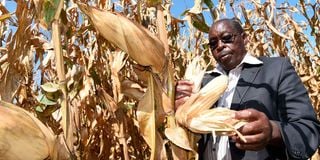Tips on harvesting dry maize for quality grains

Eijah Bett, a farmer in Sinonin, Uasin Gishu County, checks on his ready to harvest maize crop in 2020.
Last week, we looked at the harvesting of green maize on Farmer Moses' farm. He is currently selling the green maize to buyers visiting his farm. In this article, we shall look at the harvesting of dry maize.
The maize crop is usually ready for harvest when the cobs are dry and well-matured. At this point, the kernel is hard and resistant to scoring with the thumbnail.
The moisture content is usually between 23-28 per cent. In this case, the dry maize is considered to have achieved its physiological maturity. This happens when the nutrient uptake into the kernels is complete.
However, the maize should be left in the field beyond physiological maturity to allow for further drying.
The maturity indices for dry maize include maize stalks turning yellow and later brown, the cobs beginning to droop on the maize stalk and the cob husks also changing from green to yellow. The grains are usually hard and not milky. The maize cobs at this point are not the best for roasting.
Harvesting starts by cutting the maize stalks using a sickle or a machete. The maize stalks are then stooked together. Stooking refers to the leaning of maize stalks into a tee-pee-like structure. This allows the sun and air to dry the cobs, which helps to make peeling away the maize husks easier.
This should be done during the dry season to prevent the rotting of the grains. If harvesting is done during the rainy season, stooking should thus be done under a shade. While stooking, the farmer may consider cutting the tops of the plants to encourage exposure of the ears to the sun. Stooking is necessary as it allows the maize to dry and give the farmer adequate time to prepare for storage. It also makes the work easier as the maize cobs are collected from the same place.
Once the stooking has been done for a few weeks, the farmer should then snap the cobs from the stalks and remove the husks. Then dry their maize cobs in the sun until the kernels are brittle enough to begin shelling, which refers to removing the grains from the cobs.
This can be done by the use of knives, hands, or round tools referred to as shellers. In large-scale production, the harvesting is done by the use of combine harvesters, which also do the shelling.
After this stage, the maize should be dried further to have a moisture content of about 13 per cent, then be stored in sacks. The sacks should be clean to avoid contaminating the produce.
Care should be taken to prevent post-harvest losses, as this results in a loss to the farmer. Newly harvested produce should not be mixed with produce from previous harvests, as this promotes pest and disease spread.
During harvesting, care should be taken to ensure that produce is not affected in quality or quantity. Prior to harvesting, it is always ideal for the farmer to prepare for the post-harvest management practices.
In our next article, we will look at post-harvest management in maize production.





